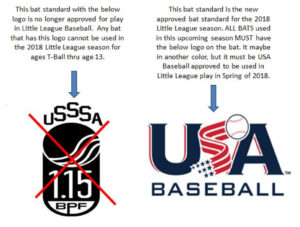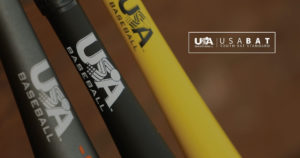EQUIPMENT
BATS



**IMPORTANT INFORMATION REGARDING DE-CERTIFIED BATS**
The biggest deal to kids at all levels is the bat! Unfortunately bats are also the most hyped by the manufacturers and getting straight information is not very easy in many cases. First let’s look at the options.
New USA Bat Standard: Beginning Jan. 1, 2018 all bats used in Little League play must have the USA label on them to show the bat conforms to the new USA bat standard.
How to Choose
For T-Ball through Minor AA there really is no reason to choose a composite or hybrid bat. Swing speeds at these levels are not high enough to reap the rewards of the higher performance and at younger ages, kids are more prone to losing or damaging them.
For Minor AAA and Majors composite bats make more sense. If your player is highly skilled and dedicated to baseball these bats can offer an edge. Otherwise there is nothing wrong with aluminum bats. They offer good performance and durability for quite a bit less.
Sizing
Most major sports retail websites have sizing charts that can assist you in picking the right length and weight. The basic rule is that the bat when placed on the floor barrel side down, the handle should come up to about bottom part of the hip. For weight, the player should be able to grab the handle with one hand and point the bat straight ahead for 20 seconds or so comfortably.
We generally recommend getting the lightest bat at the proper length as possible. Having a bat that is too heavy can cause bad swing mechanics and in some cases injury.
Shopping Tip
Bat manufacturers release new models every year. Most of the time, the composition of the bat is the exact same as last year’s model with the only change being the paint job on the outside. If you find a bat you like, look to see if last year’s model is still available and compare the bats. You can save over $120 on composite bats and $50 to $70 on aluminum bats by getting a year old model that is exactly the same!
For more bat information please visit the Little League International website regarding bats
GLOVES
With so many different types of glove available, finding the right one can be confusing even for parents with kids in league for several years. We’ll try to take some of the mystery out this below:

Figure 1 - How to measure for sizing
The most important factor in choosing a glove is to choose the proper size. The glove size is determined by two factors, age and position. For the youngest players, position may not matter as much, but the more specialized a player becomes on the field, the more they will require the glove that matches.

How to measure hand
Have the player hold out their catching hand, palm flat, in the “stop” position, fingers vertical, wrist facing down.
If a player is right-handed, they will use their left hand to catch.
If a player is left-handed, they will use their right hand to catch
Write down the measurement using the illustration above and find the glove closest to the measurement.
Sizing T-Ball through Minor AA
For the younger players 9 and under, position is not an issue as they will be playing multiple positions. Choose a middle position size such as for 3rd Base in the chart above.
Sizing AAA and Majors
By AAA, players will become more specialized. Use the chart above to find the size of the position they play most often.
Glove Material
Baseball gloves typically come in 3 different material types.
Leather
• The majority of gloves are made from this material.
• Leather offers the best comfort, control, and feel.
• Sturdy leather means stiffer gloves, but after they are broken in, this sturdiness becomes durability.
• These gloves will be stamped with a label saying “Genuine Leather”
Treated leather
• Leather is treated and softened with chemicals for faster break-in.
• Treated leather also reduces the care needed for the glove and helps the glove keep its shape.
• Treated leather should not be regarded as the same as a part fabric, part leather glove. These gloves are often very flimsy and can’t be repaired.
• Treated leather gloves typically do not last as long as untreated leather.
Synthetic materials
• A lighter, less-durable material that doesn’t hold up to the rigors of the game as well.
• Less expensive, and good for youngsters to learn with.
• Unlike leather gloves, when a synthetic or plastic glove wears out, it can’t be repaired by a professional leather worker, and should be replaced.
Pocket and Webbing Types
Pocket
• The size of the pocket depends on your position
• Shallow pockets really help middle infielders quickly grab the ball and throw
• Deeper pockets help outfielders shag down fly balls Webbing
Different styles of webbing are available to either help you better field your position or to fit your preference
• A closed web is preferred for pitchers who want to hide the ball from the batter
• Outfielders and third basemen like the extra support from a closed web
• An open web helps middle infielders get the ball out of their gloves quicker to make throws
Backs
• There are two choices of backs, open or closed
• The type of back is matter of personal preference, but some styles fit some positions better
• The open back leaves a space open across the glove's back
• Middle infielders prefer this for the flexibility
• Outfielders prefer a closed back with a "finger hole" for extra support

Figure 2- Pocket and Webbing Types
SPECIALTY GEAR
Things like catchers gear, first basemen’s gloves, wrist protectors, baseball sunglasses, batting and pitching helmets, etc. are out there for you to purchase.
The League Provides:
• Batting Helmets
• Pitching Helmets
• Catchers Gear
The rest are up to you if you wish. Some kids who are dedicated to catching may want their own gear. Most players want their own batting helmets by the time they get to Minor AA or AAA as well. Our recommendation is to take advantage of the league supplied gear at the lower levels and go from there. Be sure your player is truly dedicated to playing baseball before stocking up on all the stuff that’s out there to purchase.

FOLLOW US!
